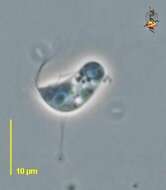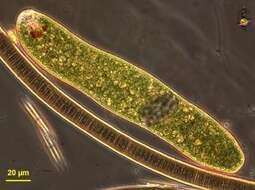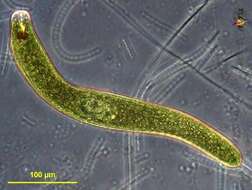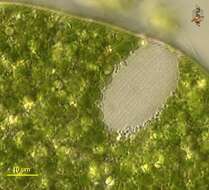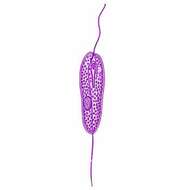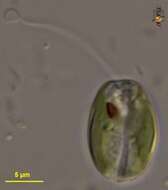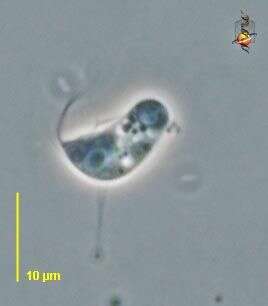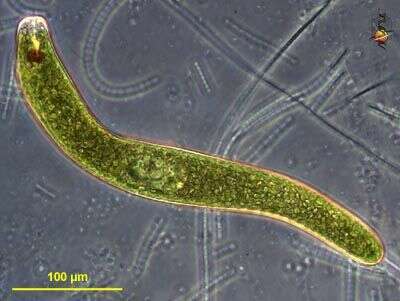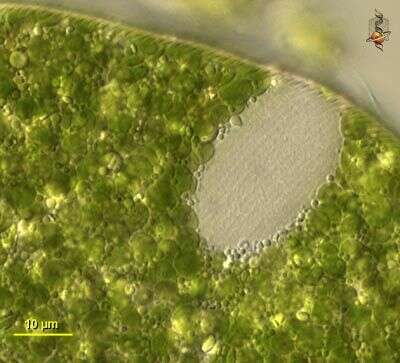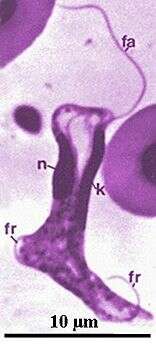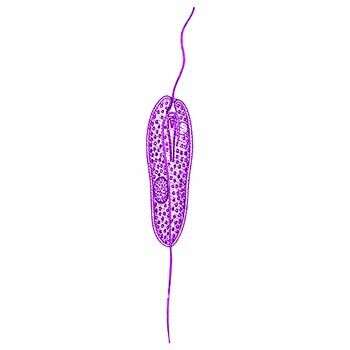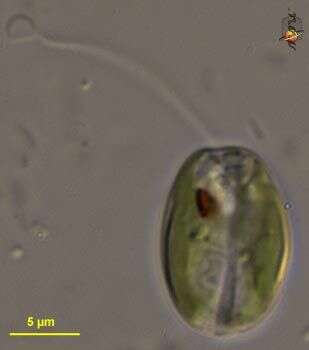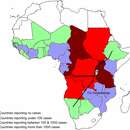-
Reclinomonas (ree-cline-owe-moan-ass) is a jakobid flagellate, cells lie recumbent in a stalked lorica, two similar flagella emerge from the anterior apex, one often lying within a ventral groove and the other projecting. May also have a rod projecting from the ventral face. Nucleus located anteriorly, contractile vacuole dorsal (near lower face in this image). Phase contrast.
-
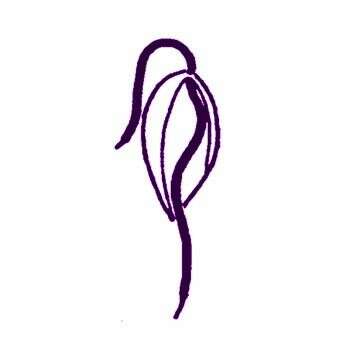
Jakoba incarcerata Bernard et al., 2000. Cells are 4 to 10microns Two flagella arise slightly sub-apically. They may be slightly acronematic. The anterior flagellum is usually shorter than the length of the cell. The posterior flagellum is up to one and a half times the length of the cell and may appear proximally thickened. The nucleus is located subapically. Food vacuoles containing bacteria are common. A refractile granule is frequently located in the middle of the cell. Typical cells are crescent-shaped with a groove occupying three quarters of the ventral face. The posterior flagellum beats with a short wavelength and amplitude pattern within the groove, often attaching to the posterior margin but with the distal portion free. Some cells lack a groove, have an ovoid to irregular profile, but have usually a posterior tail. Transformation from a grooved to a tailed profile has been observed. Grooved or tailed cells may attach to the substrate by a hooked anterior flalgellum or the tip of the posterior flagellum. Tailed cells often stick to the substrate by the tail, the cell body or irregular extensions thereof. Grooved, or more commonly, tailed cells may swim with a smooth spiral path, with the anterior flagellum directed forward. Occasionally, non-grooved cells were observed with anterior flagella up to four times the length of the cell directed posteriorly in a curving arc. These cells swim or attach to the substrate by the cell body. Electron-micrographs of cells from the type culture shows a single vane on the dorsal side of the posterior flagellum.
-
Euglena ehrenbergii. Cell observed in freshwater habitats in the vicinity of Broome, Western Australia in September 2003. This image was taken using phase contrast optics. This work was supported by the Australian Biological Resources Study.
-
Euglena ehrenbergii. Cell observed in freshwater habitats in the vicinity of Broome, Western Australia in September 2003. This work was supported by the Australian Biological Resources Study.
-
Euglena ehrenbergii. Cell observed in freshwater habitats in the vicinity of Broome, Western Australia in September 2003. This image was taken using differential interference contrast optics. This work was supported by
The Australian Biological Resources Study
-
Trypanoplasma are digenetic (two hosts) bodonid flagellates in which the recurrent flagellum is attached along the entire length of the body to form a prominent undulating membrane. Most of them live in the blood of fishes and in the vector leech. Trypanoplasma borelli infects carp and several European cyprinid fishes and is transmitted by leeches such as Piscicola geometra or Hemiclepsis marginata. Trypanoplasma borelli in the blood of fish (Giemsa), nucleus (n), kinetoplast (k), anterior flagellum (fa), recurrent flagellum (fr).
-
Dinema griseolum Perty Cells elongated, with rounded ends, 76-80 microns long, 30-40 microns Anterior flagellum about cell length and posterior flagellum about 1.5 times cell length.
-
Phacus agilis. Cell observed in freshwater habitats in the vicinity of Broome, Western Australia in September 2003. This image was taken using differential interference contrast optics. This work was supported by the Australian Biological Resources Study.

